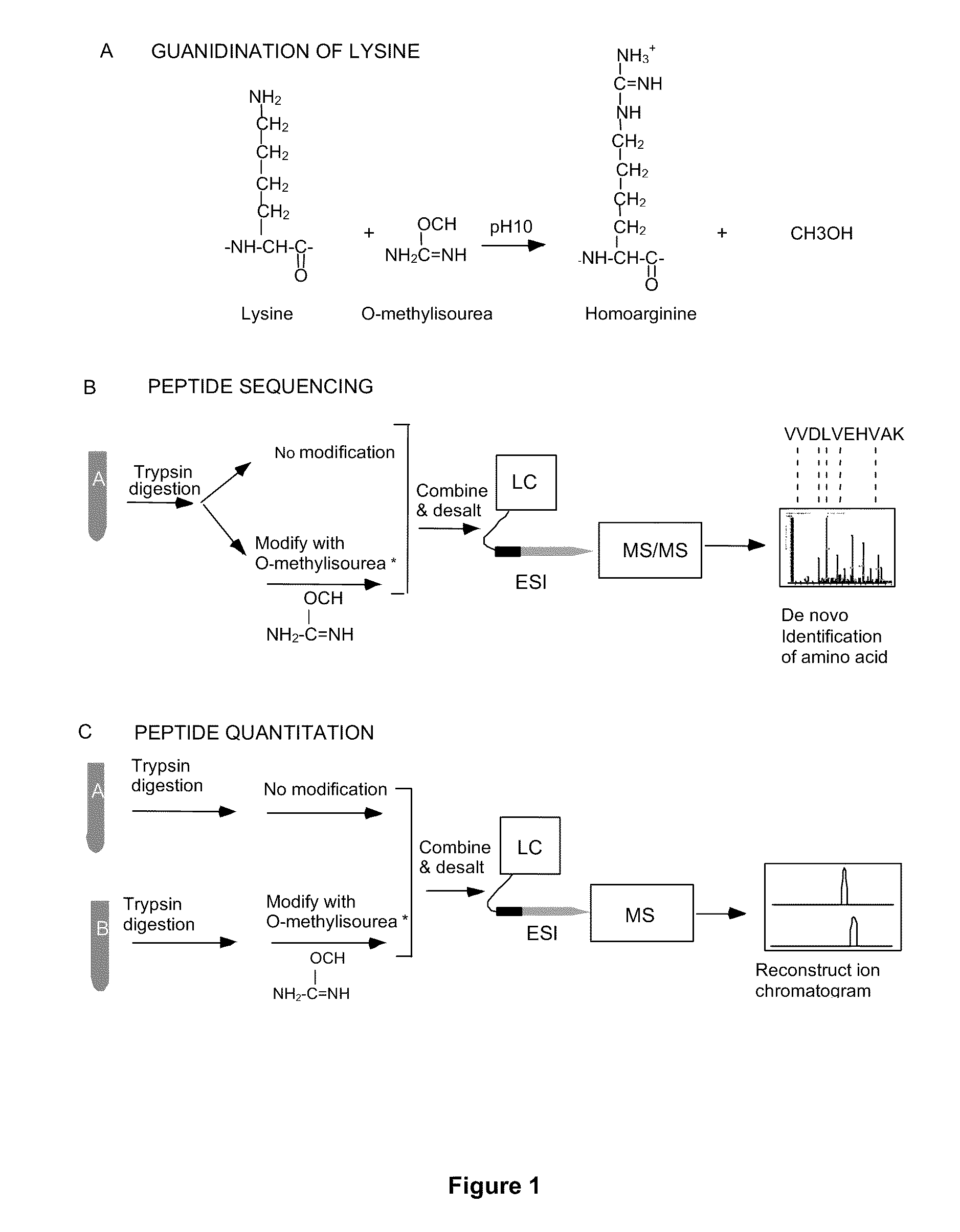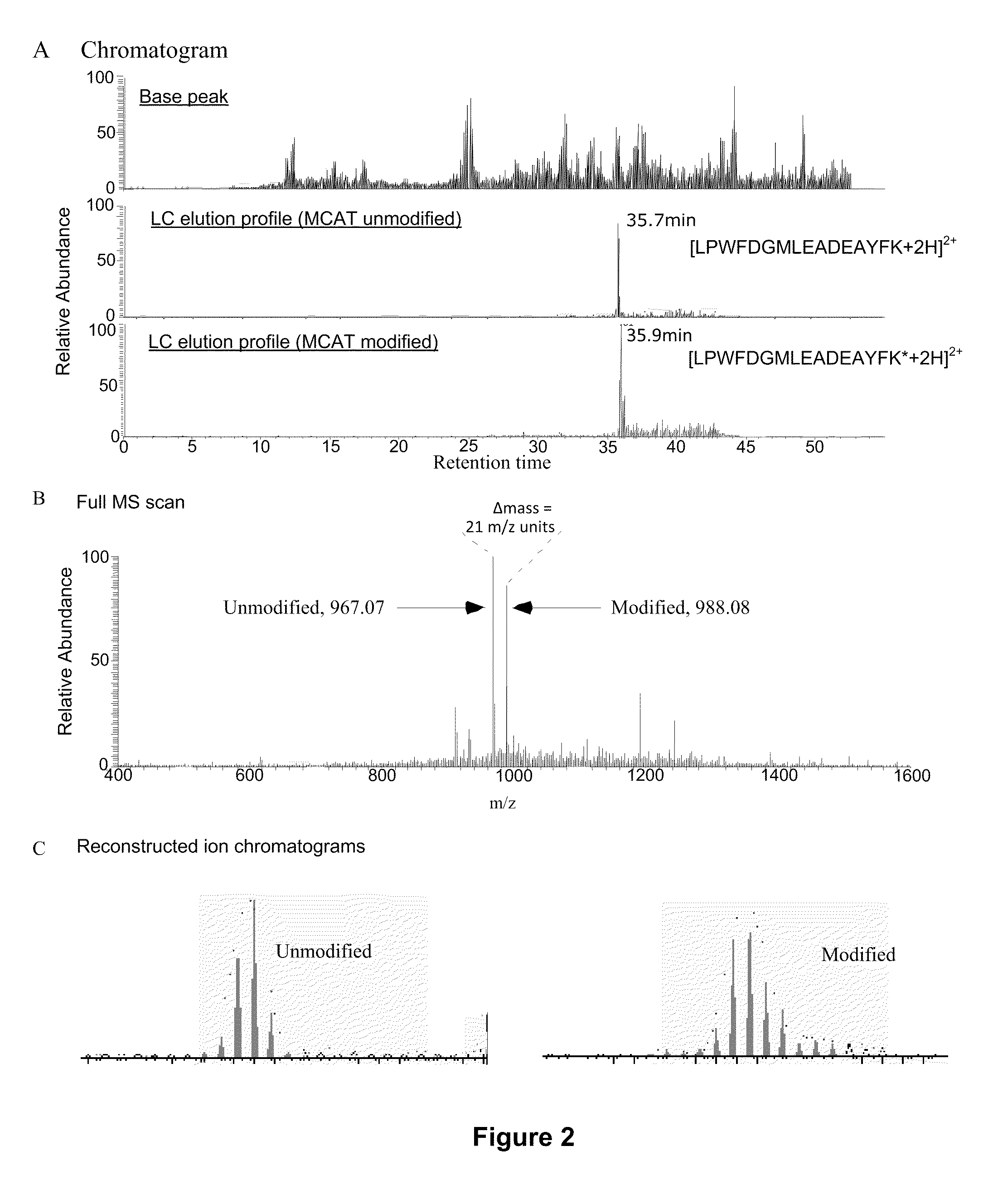Protein Expression Profile Database
a protein expression and database technology, applied in the field of peptide separation and proteomics, bioinformatics, metabolite profiling, computer databases, can solve the problems of complex spectral interpretation, difficult novo interpretation of spectra, and dramatically out-of-control ability of both academia and industry to generate new ms data, so as to facilitate the sequencing or relative abundance measurement of peptides.
- Summary
- Abstract
- Description
- Claims
- Application Information
AI Technical Summary
Benefits of technology
Problems solved by technology
Method used
Image
Examples
example 1
Measurement of Protein Relative Abundance in Complex Mixtures
[0152]The method relies on modification of peptides at ε-amine of lysine residues with O-methylisourea. Peptides so modified can be readily detected by mass spectrometry because their mass is increased by 42 Da (per lysine residue in the sequence). Therefore, the relative abundance of a single peptide from two different samples can be determined following differential modification with O-methylisourea by comparing the signal intensities for the pair in a mass spectrometer.
[0153]The steps of the MCAT procedure are as follows (FIG. 1):[0154](1) Two protein mixtures, obtained following different experimental treatments of a sample, are digested enzymatically with trypsin.[0155](2) One digest is treated with O-methylisourea and the other with control buffer.[0156](3) The digests are desalted using ZipTip reverse phase extraction.[0157](4) The two mixtures are combined and analyzed by automated electrospray LC-MS / MS. Using eith...
example 2
De Novo Peptide Sequencing and Quantitative Profiling of Complex Protein Mixtures Using Mass Coded Abundance Tagging
[0168]Introduction
[0169]There is growing recognition that qualitative and quantitative analysis of proteins on a genome-wide scale will accelerate the development of powerful new diagnostic tools and therapeutics, and lead to a better understanding of the molecular logic that governs cell behavior. This is because regulation of protein abundance holds the key to the proper function of most biological processes (Pandey & Mann, 2000). Proteomics studies depend on scalable, robust, and automated methods for protein identification and quantitation that can routinely characterize the numerous diverse proteins typically found in biological samples.
[0170]Mass spectrometry (MS) is currently the technology of choice for identifying proteins present in biological mixtures. The primary advantages of MS are its high sensitivity, accuracy and capacity. Tandem mass spectrometry (MS / ...
example 3
Use of Peptide Profiles to Characterize Human Tissue
[0225]The invention includes methods of characterizing human tissue. The method comprises generating samples suitable for MS analysis and producing a peptide profile. The relative abundance of peptides in samples is also preferably determined. The peptide profile that is generated is compared to peptide profiles in a database or library using common algorithms in order to identify cognate proteins, preferably those that are considered important therapeutic targets, as well as metabolic enzymes and structural proteins.
[0226]Table 5 shows 40 peptides sequenced and quantified from a human lung tissue lysate sample in a single LC-MS analysis that are then used to construct a unique peptide profile. The peptides in turn allowed for the identification of cognate corresponding proteins present in the sample (a total of 867 proteins were unambiguously identified in this analysis). Note that the peptides sequences obtained by a generic data...
PUM
| Property | Measurement | Unit |
|---|---|---|
| liquid phase chromatography | aaaaa | aaaaa |
| mass | aaaaa | aaaaa |
| molecular weight | aaaaa | aaaaa |
Abstract
Description
Claims
Application Information
 Login to View More
Login to View More - R&D
- Intellectual Property
- Life Sciences
- Materials
- Tech Scout
- Unparalleled Data Quality
- Higher Quality Content
- 60% Fewer Hallucinations
Browse by: Latest US Patents, China's latest patents, Technical Efficacy Thesaurus, Application Domain, Technology Topic, Popular Technical Reports.
© 2025 PatSnap. All rights reserved.Legal|Privacy policy|Modern Slavery Act Transparency Statement|Sitemap|About US| Contact US: help@patsnap.com



